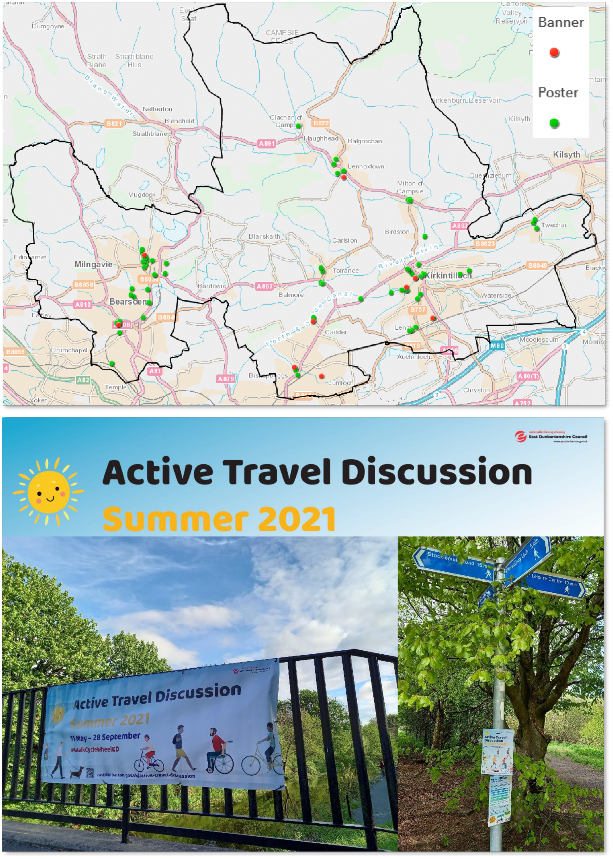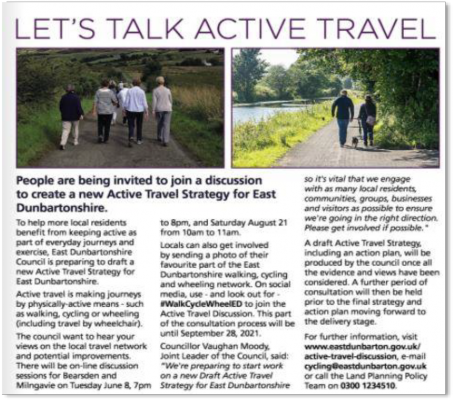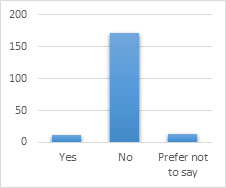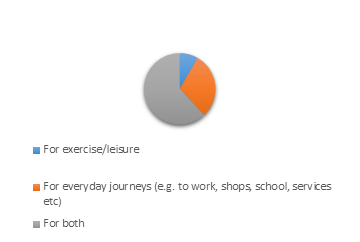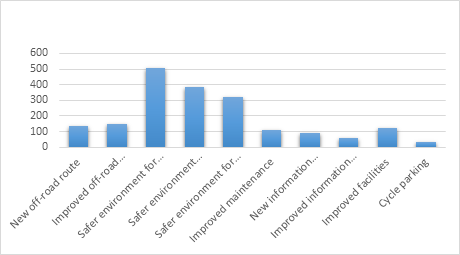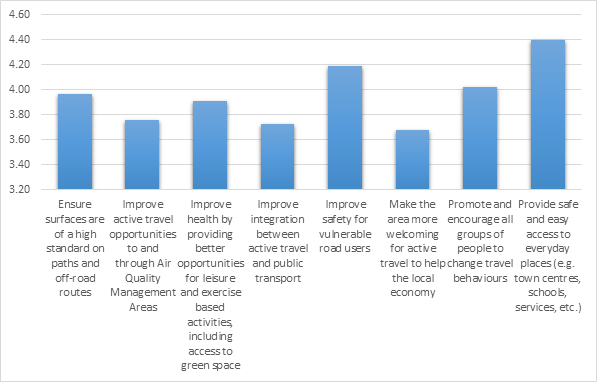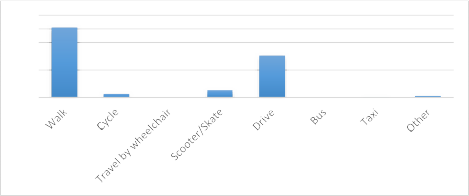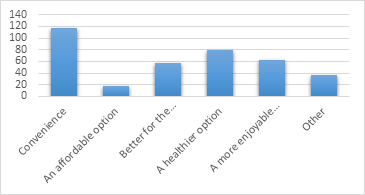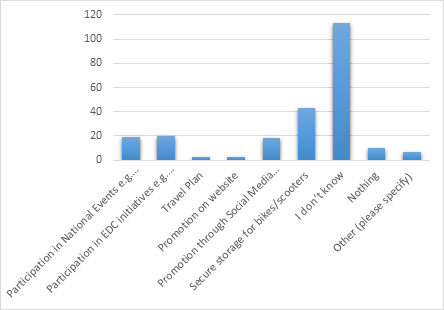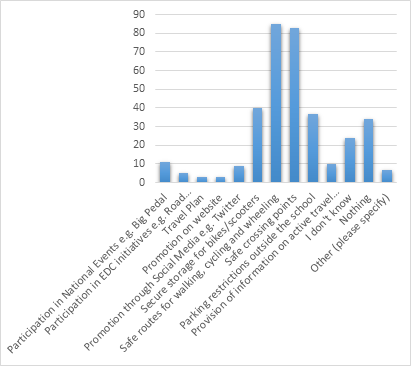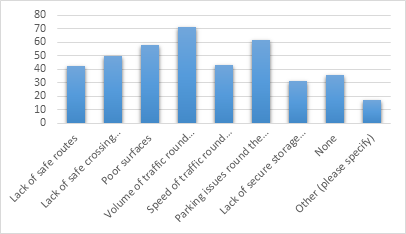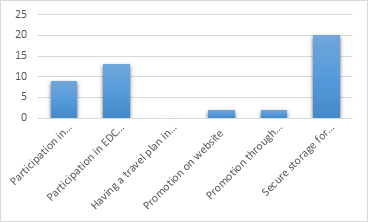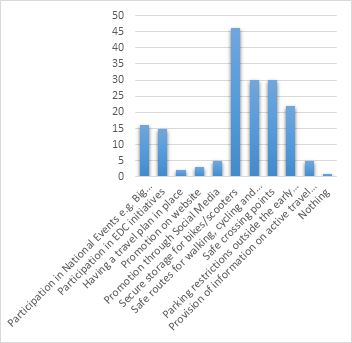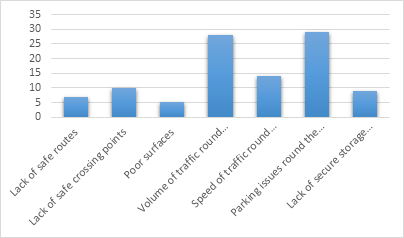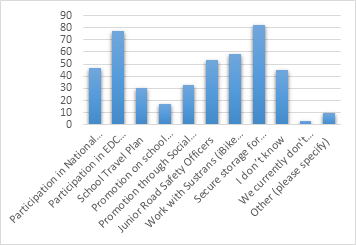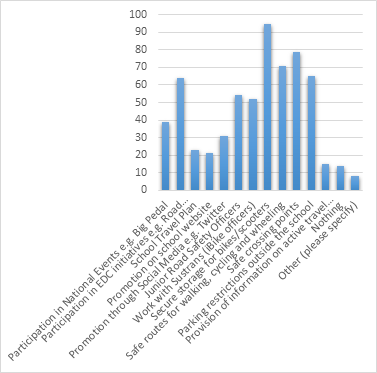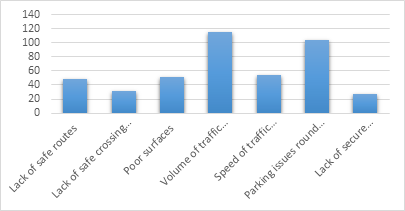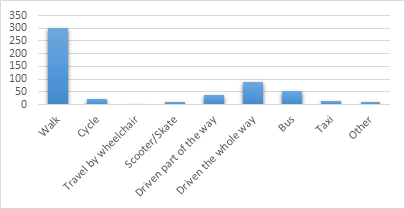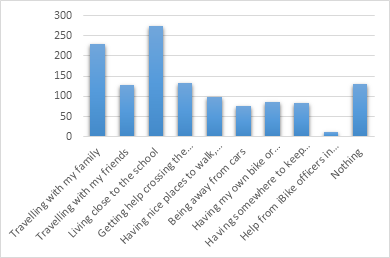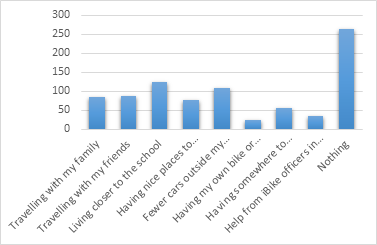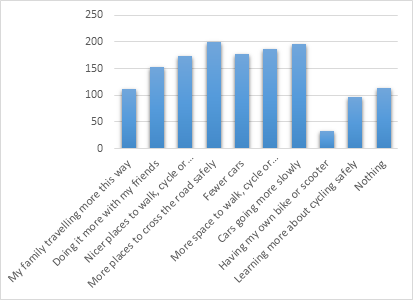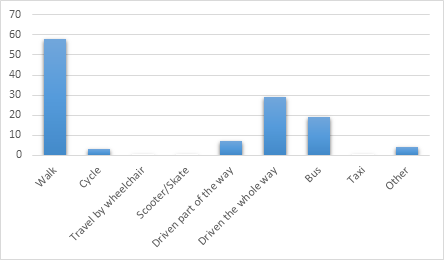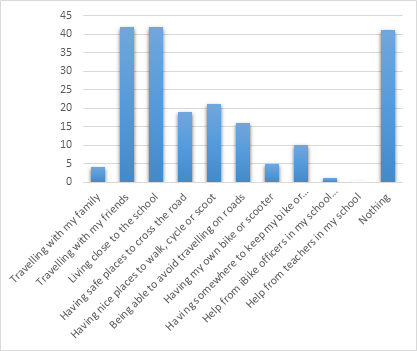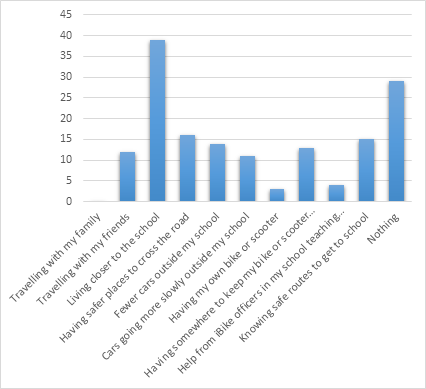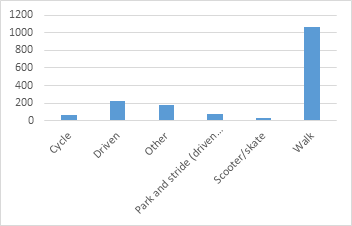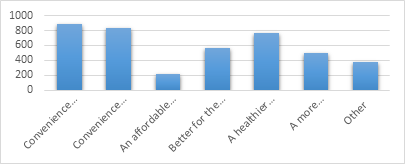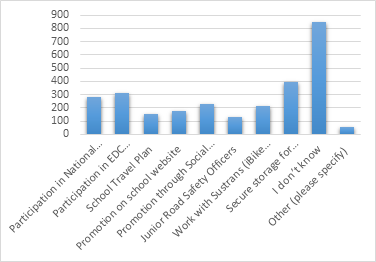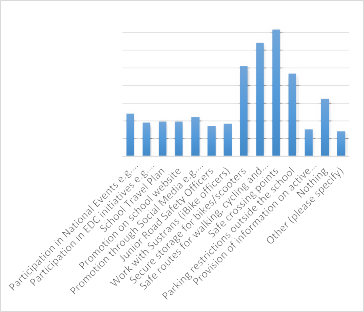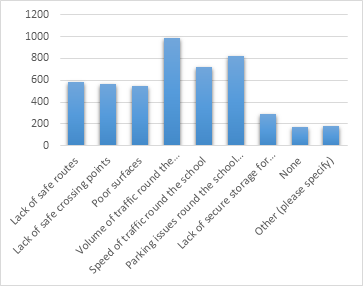Introduction
The Council held significant consultation as work was undertaken to develop the Local Transport Strategy 2020-2025. While some responses suggested that the focus was shifted away from active travel there was clear representation from individuals, community groups and other stakeholders that more ambition and urgency should be shown by the Council to make it easier for people to get about by walking, cycling and wheeling. In response to this, the Council committed to producing a second Active Travel Strategy and the LTS outlined a delivery plan for achieving this. The delivery plan included the Council carrying out extensive option generation and engagement with local communities and stakeholders. This would allow all interested parties to have their say on what the strategy should prioritise and suggest ideas for possible projects. To achieve this, the Active Travel Discussion was held between May and September 2021. This period was designed to take place over the summer to encourage people to use and experience the local active travel network before suggesting how it could be improved and/or expanded.
This section outlines the activities the Council undertook to raise awareness of the Active Travel Discussion, the engagement methods used and a summary of the results.
On this page you will find information on:
- Awareness raising methods
- Explore, Enjoy East Dunbartonshire
- Schools
- Newsletter
- Local Media
- Consultation Activities
- Schools active travel discussion
- Social media and email responses
- Consultation results
- Online sessions
- Schools survey results
- Conclusion
Awareness raising methods
Social media
A variety of engaging social media content was produced by the Council to promote the Active Travel Discussion and to let people know how they could get involved. This content included an animated video, graphics, pictures and more. This content was shared on the Council’s Twitter and Facebook feeds which allowed other national and local organisations to share it with followers of their pages, widening the reach of the promotional material. The hashtag #WalkCycleWheelED helped facilitate online discussion.
The figure below highlights how far the content reached and a collection of other organisations who helped spread the word is on the next page.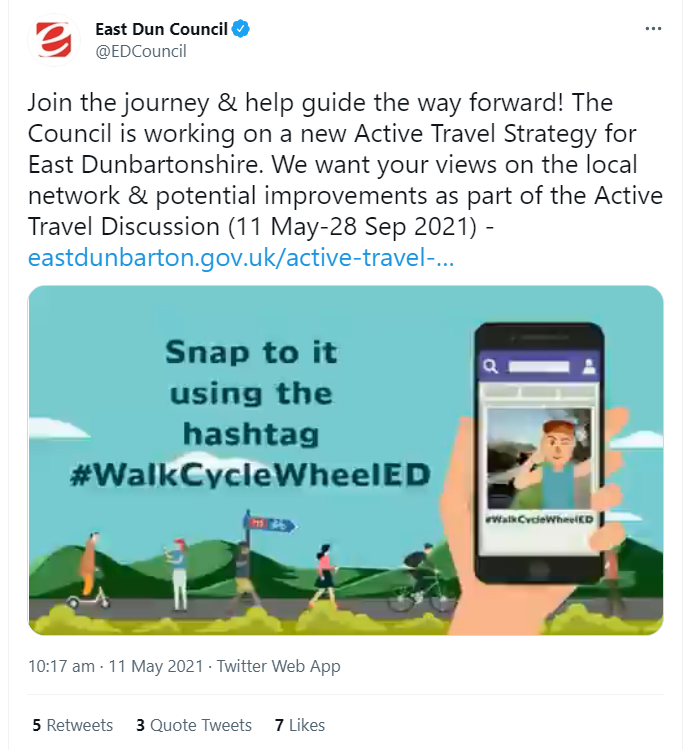
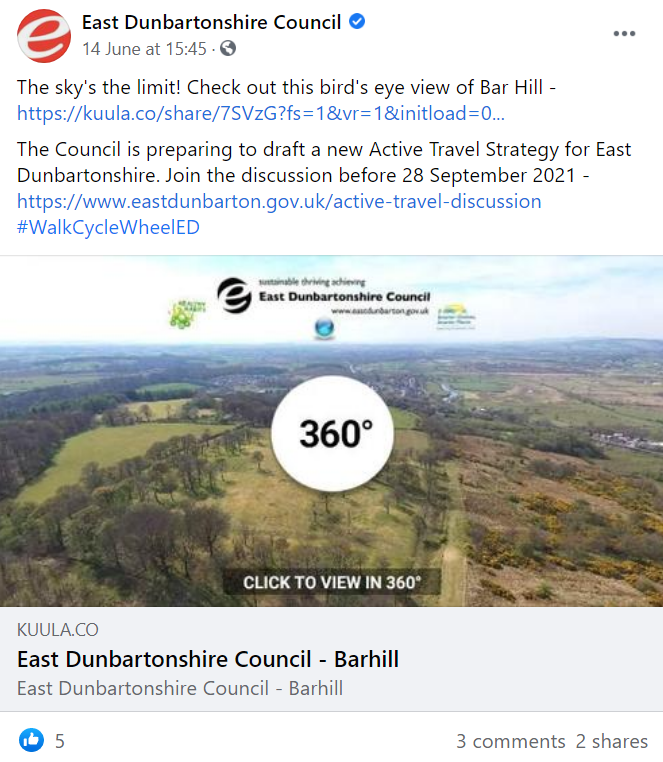
A variety of engaging social media content was produced by the Council to promote the Active Travel Discussion and to let people know how they could get involved. This content included an animated video, graphics, pictures and more. This content was shared on the Council’s Twitter and Facebook feeds which allowed other national and local organisations to share it with followers of their pages, widening the reach of the promotional material. The hashtag #WalkCycleWheelED helped facilitate online discussion.
The figure below highlights how far the content reached and a collection of other organisations who helped spread the word is on the next page.
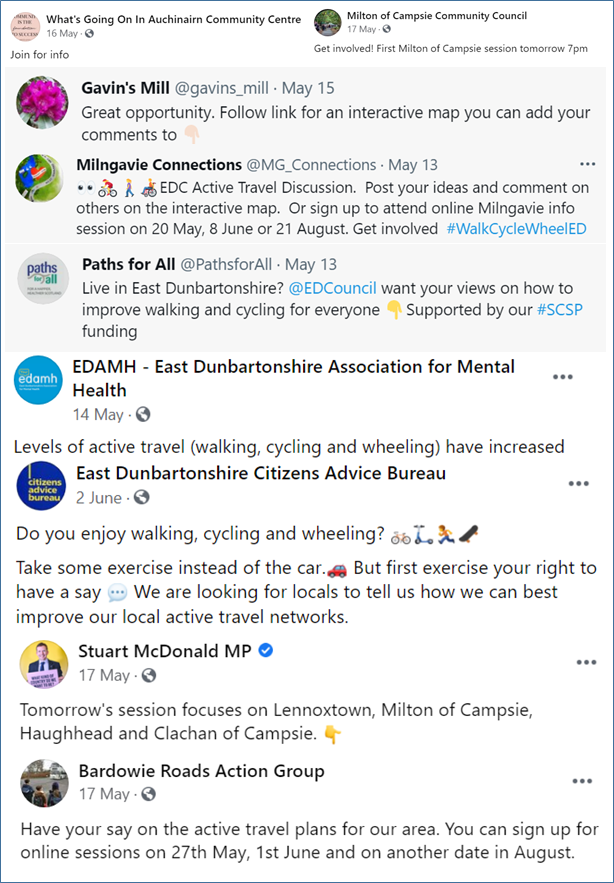

Active Nation Commissioner
Lee Craigie is Scotland’s Active Nation Commissioner. It is Lee’s job to ensure that more people have the opportunity to be more active, more often. The Council worked with Lee to launch the Active Travel Discussion at Milngavie Primary School. Lee joined pupils and staff on a led ride organised by the Council’s iBike officers and talked to the pupils about active travel and what they would like to see happen in their local area. Lee produced a short video of her day in East Dunbartonshire, encouraging people to get involved in the Active Travel Discussion to ensure their views are heard. This video is available to view (with subtitles) on the Council’s YouTube channel.
Lee was also able to share work on the Active Travel Discussion and her conversations with local children on her social media channels, again increasing awareness of the consultation.
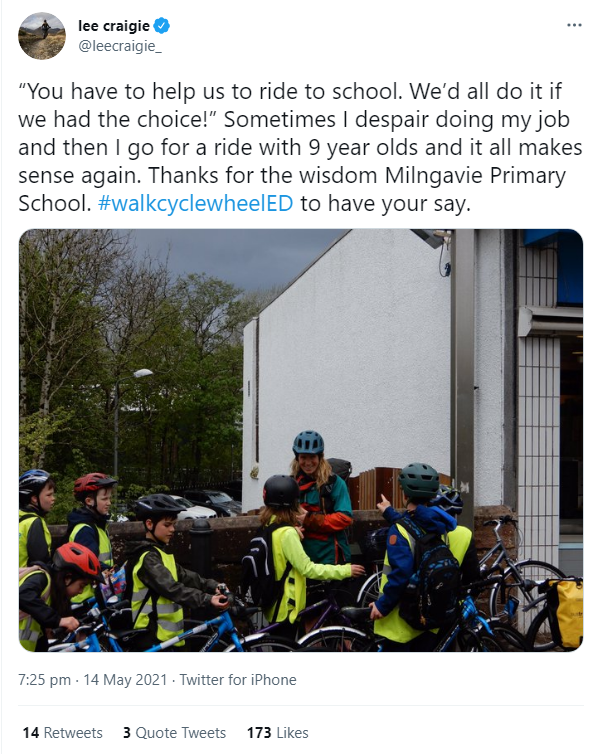
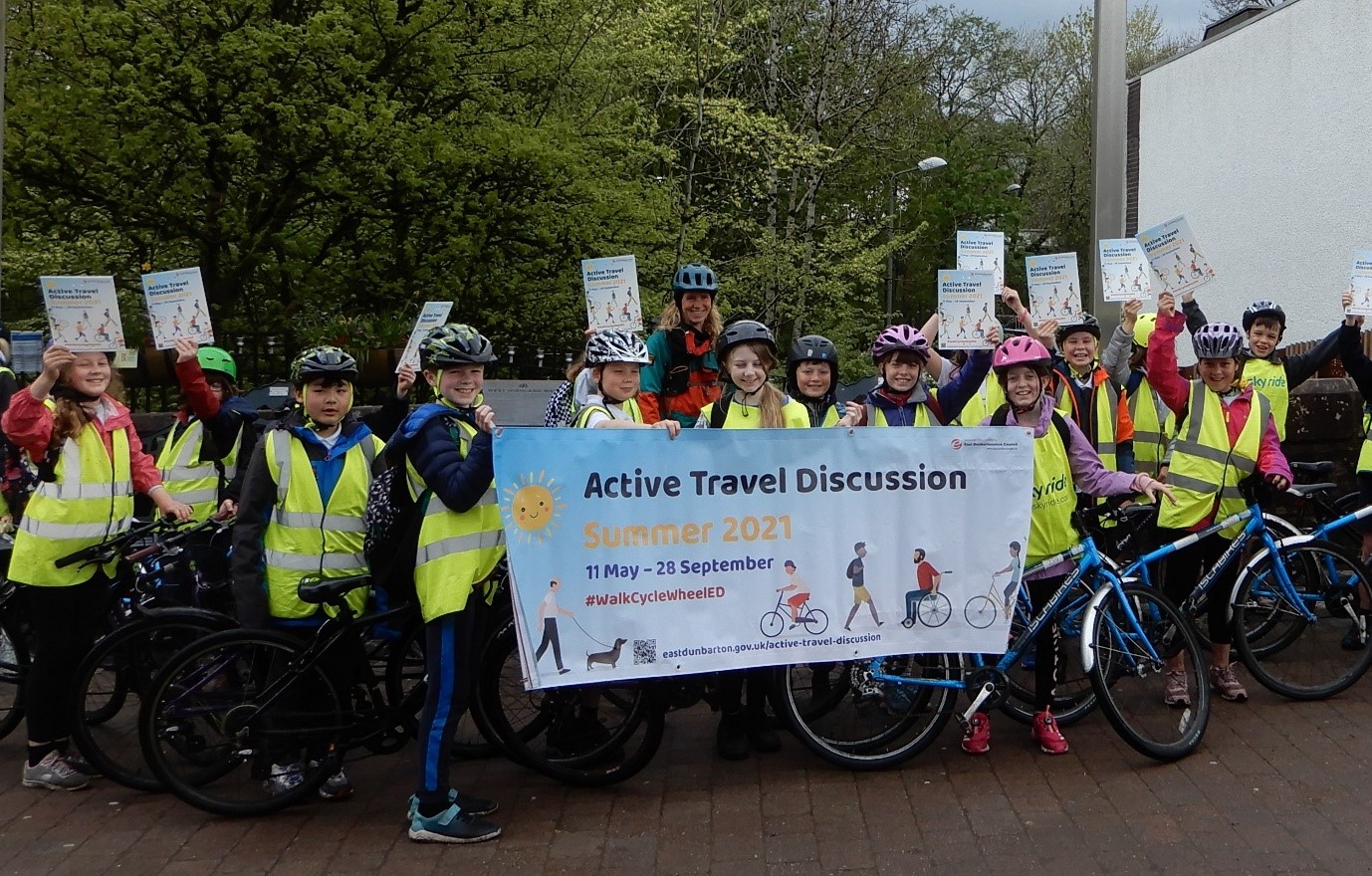
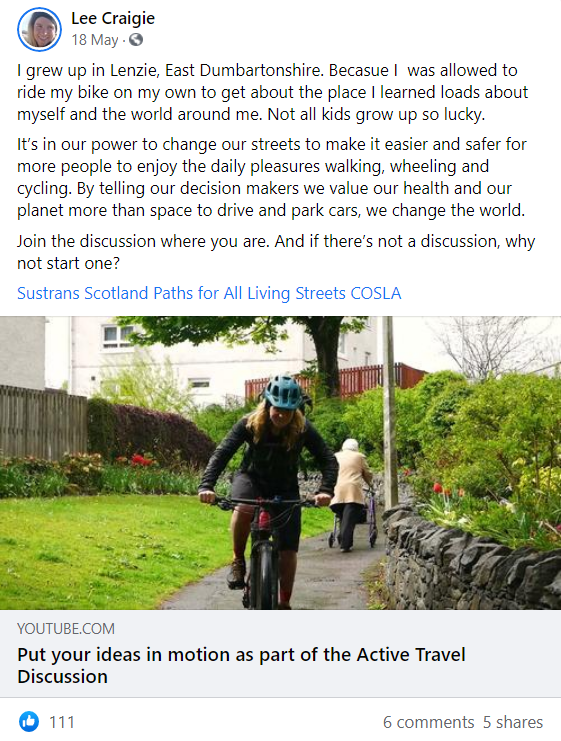
Signage
Banners and posters were produced by the Council and spread over 100 locations across the authority to raise awareness of the consultation and encourage people with ideas to inform the Council how the network could be improved or expanded.
Local media
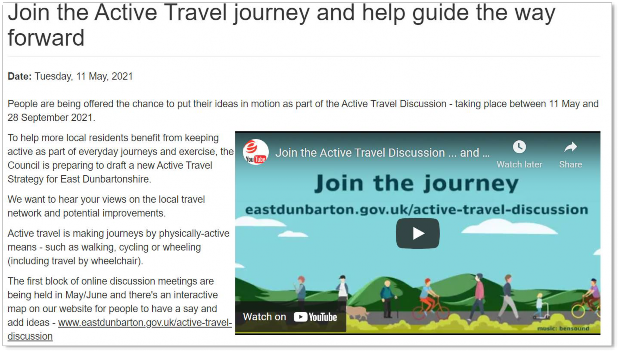
The Council issued press releases to media outlets to raise awareness of the Active Travel Discussion. Local people were encouraged to ‘join the journey’ with local newspapers and magazines publishing stories throughout the consultation period. Efforts were also made to tie in with other press releases for Council consultations including the Greenspace Strategy, Climate Action Plan and City Deal projects.
Explore, Enjoy East Dunbartonshire
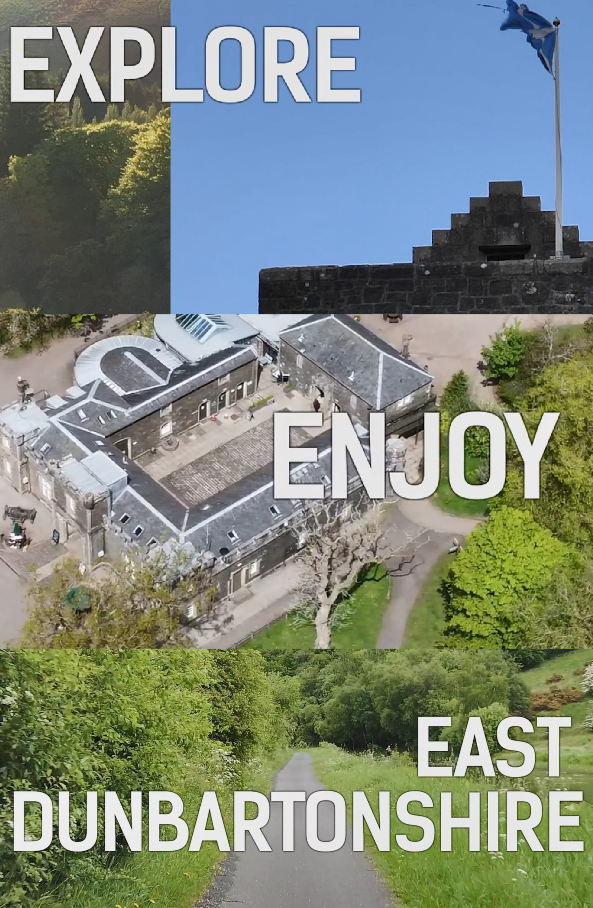 The ‘Explore, Enjoy East Dunbartonshire’ short films shine the spotlight on attractions and opportunities to travel actively. – including walking, cycling and wheeling. The videos were part of efforts to encourage more people to enjoy local tourism assets and active travel networks across the summer months as well as raise awareness of the Active Travel Discussion.
The ‘Explore, Enjoy East Dunbartonshire’ short films shine the spotlight on attractions and opportunities to travel actively. – including walking, cycling and wheeling. The videos were part of efforts to encourage more people to enjoy local tourism assets and active travel networks across the summer months as well as raise awareness of the Active Travel Discussion.
The series features routes from the Council’s Walking and Cycling Map, with all films added to the Council’s social media accounts and uploaded to the Council’s YouTube page.
The six films featured the following routes:
- Bar Hill
- Craigdhu Way
- Forth and Clyde Canal
- Mugdock Explorer
- Strathkelvin Railway Path
- Thomas Muir Heritage Trail
Schools
As well as featuring in the consultation launch, schools have been heavily involved throughout the Active Travel Discussion. Headteachers of all schools in East Dunbartonshire passed on information to pupils, staff, parents and carers encouraging them to participate and complete bespoke school surveys. Further information on these results is included in the Consultation Results section .
Newsletter
The Land Planning Policy Team’s newsletter was distributed multiple times before the consultation period and within the consultation period which included details of the consultation. This newsletter is distributed via email and is sent to a wide range of stakeholders including residents, key agencies, developers and consultancies. The newsletter (March 2021).
Excerpt from March 2021 newsletter encouraging participation in the Active Travel Discussion
Local Media
The Council issued press releases to media outlets to raise awareness of the Active Travel Discussion. Local people were encouraged to ‘join the journey’ with local newspapers and magazines publishing stories throughout the consultation period. Efforts were also made to tie in with other press releases for Council consultations including the Greenspace Strategy, Climate Action Plan and City Deal projects.
Consultation Activities
Ideas Map
The ideas map is an interactive tool used to provide comments or pictures and share ideas with others for particular locations. Participants could show support for suggestions using a like function although, except for some suggestions, using the like function to determine the popularity of a suggestion is unreliable as suggestions submitted earlier tended to attract more likes. That said, there are examples where popular ideas get significantly more likes than others.
Further detail on ideas received is available in Section G: Options generated and H: Appendix.
Online sessions
A total of twelve online sessions took place between May and September 2021. There were three sessions allocated for each of the four community areas in East Dunbartonshire. The online discussion sessions aimed to provide participants with information on the processes being followed to prepare a new Active Travel Strategy and a summary of the consultation arrangements. This included a presentation of the ideas map and how this tool is used in the consultation and options generation processes. Furthermore, these online sessions had time scheduled for discussion either related to presentation content or general, providing participants with the opportunity to discuss any ideas about active travel and making it an easier, safer option in East Dunbartonshire
Twelve sessions at different times of day were proposed to maximise the number of people who could be available to attend a session.
Schools active travel discussion
As part of both the Parking Management Plan and the Active Travel Strategy, consultation with stakeholders at schools in East Dunbartonshire took place. There were different surveys conducted of early years parents (181 participants), early years staff (45 participants), primary pupils (541 participants), secondary pupils (120 participants), school staff (153 participants) and school parents (1585 participants).
It is important to understand school travel habits and the barriers to using active travel to get to and from school to foster a long-term shift from unsustainable modes towards sustainable travel and nourishing a culture where active travel is a safe, easy and convenient choice.
Social media and email responses
As well as processes carried out specifically for consultation on the Active Travel Strategy, the Council welcomes correspondence through other means.
Emails were received at cycling@eastdunbarton.gov.uk, a council email address dedicated to correspondence relating to consultation on the Active Travel Strategy. Emails were received from individuals, groups and Ross Greer MSP.
Two phone calls with three separate participants were received during the consultation period.
Around 30 emails were received from individuals during the consultation period.
Tweets have been useful to understand perspectives towards the promotion of active travel in East Dunbartonshire.
Consultation results
Detailed results of the options generated from the ideas map and submissions received through other means will be explored in more detail in Section F: Options generated.
Ideas map
This was a well-used feature of the Active Travel Discussion with 1,084 total suggestions received from 301 participants. The options generated through the ideas map are particularly valuable due to the large number of participants, the ease at which a variety of different people can access the map and the fact that ideas will have largely come from the lived experience of people who are most familiar with East Dunbartonshire and where improvements in active travel can be made.
The suggestions made in the ideas map form the basis of the options generation process and, rather than being discussed in detail in this section of the report, specifics of the ideas proposed will be analysed in Section F. Options generation.
This section will briefly describe who contributed to the ideas map and the broad aims of those who responded.
Demographics
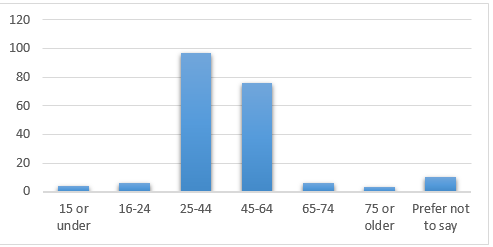
| Age of respondents: | number of people |
|---|---|
|
15 or under |
4 |
|
16-24 |
6 |
|
25-44 |
97 |
|
45-64 |
76 |
|
65-74 |
6 |
|
75 or older |
3 |
|
Prefer not to say |
10 |
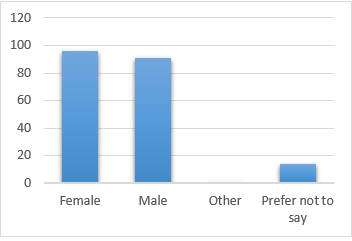
| Gender | Number of people |
|---|---|
|
Female |
96 |
|
Male |
91 |
|
Other |
1 |
|
Prefer not to say |
14 |
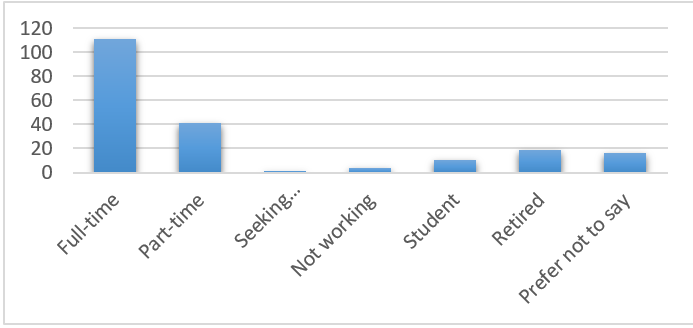
| Employment | number of people |
|---|---|
|
Full-time |
111 |
|
Part-time |
41 |
|
Seeking employment |
1 |
|
Not working |
4 |
|
Student |
10 |
|
Retired |
19 |
|
Prefer not to say |
16 |
| Disability | number of people |
|---|---|
|
Yes |
11 |
|
No |
172 |
|
Prefer not to say |
13 |
Types of suggestions
Suggesting new infrastructure or changing existing infrastructure:
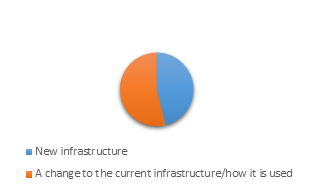
|
New infrastructure |
360 |
|
A change to the current infrastructure/how it is used |
420 |
Exercise/leisure, everyday journeys or both?
|
For exercise/leisure |
66 |
|
For everyday journeys (e.g. to work, shops, school, services etc) |
235 |
|
For both |
489 |
Type of idea
|
New off-road route |
136 |
|
Improved off-road route |
146 |
|
Safer environment for walking |
507 |
|
Safer environment on-road for cycling |
388 |
|
Safer environment for wheeling |
323 |
|
Improved maintenance |
111 |
|
New information signage |
89 |
|
Improved information signage |
56 |
|
Improved facilities |
120 |
|
Cycle parking |
31 |
Priorities (average score out of five):
|
Ensure surfaces are of a high standard on paths and off-road routes |
3.97 |
Improve safety for vulnerable road users |
4.19 |
|
Improve active travel opportunities to and through Air Quality Management Areas |
3.76 |
Make the area more welcoming for active travel to help the local economy |
3.68 |
|
Improve health by providing better opportunities for leisure and exercise-based activities, including access to green space |
3.91 |
Promote and encourage all groups of people to change travel behaviours |
4.02 |
|
Improve integration between active travel and public transport |
3.73 |
Provide safe and easy access to everyday places (e.g. town centres, schools, services, etc.) |
4.40 |
Online sessions
The online sessions brought about valuable discussions with engaged residents and groups. Across twelve sessions, a total of 48 participants attended and many valuable contributions were made from specific suggestions for places to ideas relevant to East Dunbartonshire as a whole. While it was an important process in that anyone could attend, meet officers and share their views, a process that demands less time and skills of participants (the ideas map) needed to run concurrently to ensure as many people as possible could shape the Active Travel Discussion.
These online sessions enabled discussion of themes which are more difficult to address in the ideas map such as the public and political acceptability of active travel spending, frustration at a lack of pace of change, wider networks and funding.
All ideas brought forward in these sessions will be analysed further in Section G. Options generation.
Schools survey results
Early years parents
Early years parents were asked what their most frequent method of travel to early years centres were:
|
Walk |
102 |
|---|---|
|
Cycle |
5 |
|
Travel by wheelchair |
0 |
|
Scooter/Skate |
10 |
|
Drive |
61 |
|
Bus |
0 |
|
Taxi |
1 |
|
Other |
2 |
They were asked the reason for this choice:
|
Convenience |
117 |
|---|---|
|
An affordable option |
18 |
|
Better for the environment |
58 |
|
A healthier option |
79 |
|
A more enjoyable option |
62 |
|
Other |
36 |
They were asked how their early years centre promotes active travel:
|
Participation in National Events e.g. Big Pedal |
19 |
|---|---|
|
Participation in EDC initiatives e.g. Road Safety Calendar |
20 |
|
Travel Plan |
3 |
|
Promotion on website |
3 |
|
Promotion through Social Media e.g. Twitter |
18 |
|
Secure storage for bikes/scooters |
43 |
|
I don’t know |
113 |
|
Nothing |
10 |
|
Other (please specify) |
7 |
They were asked what currently works well in encouraging them and their child(ren) to travel actively to their early years centre:
|
Participation in National Events e.g. Big Pedal |
11 |
|---|---|
|
Participation in EDC initiatives e.g. Road Safety Calendar |
5 |
|
Travel Plan |
3 |
|
Promotion on website |
3 |
|
Promotion through Social Media e.g. Twitter |
9 |
|
Secure storage for bikes/scooters |
40 |
|
Safe routes for walking, cycling and wheeling |
85 |
|
Safe crossing points |
83 |
|
Parking restrictions outside the school |
37 |
|
Provision of information on active travel routes |
10 |
|
I don't know |
24 |
|
Nothing |
34 |
|
Other (please specify) |
7 |
They were asked about the challenges for active travel to their centre:
|
Lack of safe routes |
42 |
|---|---|
|
Lack of safe crossing points |
50 |
|
Poor surfaces |
58 |
|
Volume of traffic near the centre |
71 |
|
Speed of traffic near the centre |
43 |
|
Parking issues near the centre (e.g. volume of cars and inconsiderate parking) |
62 |
|
Lack of secure storage for bikes/scooters |
31 |
|
None |
36 |
|
Other (please specify) |
17 |
- Early years staff
There is a range of different roles represented by survey participants.
|
Teacher |
7 |
Depute Head of Centre / Depute Head Teacher |
3 |
|
Senior |
5 |
Early Years Worker |
21 |
|
Early Years Support Worker |
9 |
|
|
Early years staff were asked how their early years centre promotes active travel to/from the facility:
|
Participation in national events, e.g. Big Pedal |
9 |
|---|---|
|
Participation in EDC initiatives |
13 |
|
Having a travel plan in place |
0 |
|
Promotion on website |
2 |
|
Promotion through social media |
2 |
|
Secure storage for bikes/scooters |
20 |
|
Other (please specify) |
0 |
They were asked what currently works well in encouraging active travel to/from the centre:
|
Participation in National Events e.g. Big Pedal |
16 |
|---|---|
|
Participation in EDC initiatives |
15 |
|
Having a travel plan in place |
2 |
|
Promotion on website |
3 |
|
Promotion through Social Media |
5 |
|
Secure storage for bikes/scooters |
46 |
|
Safe routes for walking, cycling and wheeling |
30 |
|
Safe crossing points |
30 |
|
Parking restrictions outside the early years centre |
22 |
|
Provision of information on active travel routes |
5 |
|
Nothing |
1 |
|
Other (please specify) |
0 |
They were asked what challenges there are to active travel.
|
Lack of safe routes |
7 |
|---|---|
|
Lack of safe crossing points |
10 |
|
Poor surfaces |
5 |
|
Volume of traffic around centre |
28 |
|
Speed of traffic around the centre |
14 |
|
Parking issues around the centre (e.g. volume of cars and inconsiderate parking) |
29 |
|
Lack of secure storage for bikes/scooters |
9 |
|
None |
0 |
- School staff
The survey received responses from various roles within schools with teachers best represented.
|
Head Teacher |
8 |
Teacher |
79 |
|---|---|---|---|
|
Depute Head Teacher |
6 |
Support Staff |
28 |
|
Principal Teacher |
21 |
Other (please specify) |
11 |
School staff were asked how they currently promote active travel to school.
|
Participation in National Events e.g. Big Pedal |
47 |
|---|---|
|
Participation in EDC initiatives e.g. Road Safety Calendar |
77 |
|
School Travel Plan |
30 |
|
Promotion on school website |
17 |
|
Promotion through Social Media e.g. Twitter |
33 |
|
Junior Road Safety Officers |
53 |
|
Work with Sustrans (iBike officers) |
58 |
|
Secure storage for bikes/scooters |
82 |
|
I don’t know |
45 |
|
We currently don't promote active travel |
3 |
|
Other (please specify) |
10 |
They were asked about what currently works well in encouraging active travel to school.
|
Participation in National Events e.g. Big Pedal |
39 |
|---|---|
|
Participation in EDC initiatives e.g. Road Safety Calendar |
64 |
|
School Travel Plan |
23 |
|
Promotion on school website |
21 |
|
Promotion through Social Media e.g. Twitter |
31 |
|
Junior Road Safety Officers |
54 |
|
Work with Sustrans (iBike officers) |
52 |
|
Secure storage for bikes/scooters |
95 |
|
Safe routes for walking, cycling and wheeling |
71 |
|
Safe crossing points |
79 |
|
Parking restrictions outside the school |
65 |
|
Provision of information on active travel routes |
15 |
|
Nothing |
14 |
|
Other (please specify) |
8 |
They were asked what the challenges were to active travel at their school.
|
Lack of safe routes |
49 |
|---|---|
|
Lack of safe crossing points |
32 |
|
Poor surfaces |
52 |
|
Volume of traffic around school |
115 |
|
Speed of traffic around school |
54 |
|
Parking issues around school (e.g. volume of cars and inconsiderate parking) |
104 |
|
Lack of secure storage for bikes/scooters |
27 |
- Primary pupils
Primary pupils were asked how they most travelled to school.
|
Walk |
301 |
|---|---|
|
Cycle |
24 |
|
Travel by wheelchair |
1 |
|
Scooter/Skate |
12 |
|
Driven part of the way |
37 |
|
Driven the whole way |
89 |
|
Bus |
53 |
|
Taxi |
13 |
|
Other |
11 |
They were asked what makes it easy to cycle or scoot - if they do this.
|
Travelling with my family |
229 |
|---|---|
|
Travelling with my friends |
128 |
|
Living close to the school |
274 |
|
Getting help crossing the road |
134 |
|
Having nice places to walk, cycle or scoot |
98 |
|
Being away from cars |
75 |
|
Having my own bike or scooter |
86 |
|
Having somewhere to keep my bike or scooter while I’m in school |
83 |
|
Help from iBike officers in my school teaching me how to cycle safely |
11 |
|
Nothing |
131 |
They were asked what would help them travel actively to school.
|
Travelling with my family |
85 |
|---|---|
|
Travelling with my friends |
88 |
|
Living closer to the school |
124 |
|
Having nice places to walk, cycle or scoot |
76 |
|
Fewer cars outside my school |
109 |
|
Having my own bike or scooter |
24 |
|
Having somewhere to keep my bike or scooter while I’m in school |
54 |
|
Help from iBike officers in my school teaching me how to cycle safely |
33 |
|
Nothing |
263 |
They were asked what would help them to walk or cycle generally.
|
My family travelling more this way |
111 |
|---|---|
|
Doing it more with my friends |
153 |
|
Nicer places to walk, cycle or scoot away from the road |
173 |
|
More places to cross the road safely |
200 |
|
Fewer cars |
178 |
|
More space to walk, cycle or scoot away from cars |
187 |
|
Cars going more slowly |
196 |
|
Having my own bike or scooter |
32 |
|
Learning more about cycling safely |
97 |
|
Nothing |
114 |
- Secondary pupils
There was a consistent spread of participants from different school years.
|
1st year |
19 |
4th year |
26 |
|---|---|---|---|
|
2nd year |
20 |
5th year |
16 |
|
3rd year |
24 |
6th year |
15 |
Pupils were asked how they mostly travelled to school.
|
Walk |
58 |
|---|---|
|
Cycle |
3 |
|
Travel by wheelchair |
0 |
|
Scooter/Skate |
0 |
|
Driven part of the way |
7 |
|
Driven the whole way |
29 |
|
Bus |
19 |
|
Taxi |
0 |
|
Other |
4 |
They were asked what makes it easy for them to travel actively, if they do so.
|
Travelling with my family |
4 |
|---|---|
|
Travelling with my friends |
42 |
|
Living close to the school |
42 |
|
Having safe places to cross the road |
19 |
|
Having nice places to walk, cycle or scoot |
21 |
|
Being able to avoid travelling on roads |
16 |
|
Having my own bike or scooter |
5 |
|
Having somewhere to keep my bike or scooter while I’m in school |
10 |
|
Help from iBike officers in my school teaching me how to cycle safely |
1 |
|
Help from teachers in my school |
0 |
|
Nothing |
41 |
They were asked what would help them to travel actively to school if they did not do so already.
|
Travelling with my family |
0 |
|---|---|
|
Travelling with my friends |
12 |
|
Living closer to the school |
39 |
|
Having safer places to cross the road |
16 |
|
Fewer cars outside my school |
14 |
|
Cars going more slowly outside my school |
11 |
|
Having my own bike or scooter |
3 |
|
Having somewhere to keep my bike or scooter while I’m in school |
13 |
|
Help from iBike officers in my school teaching me how to cycle safely |
4 |
|
Knowing safe routes to get to school |
15 |
|
Nothing |
29 |
- Parents
Parents were asked how their children got to and from school. As many parents have multiple children, the sample size is large.
|
Cycle |
62 |
|---|---|
|
Driven |
227 |
|
Other |
179 |
|
Park and stride (driven part way) |
72 |
|
Scooter/skate |
37 |
|
Walk |
1066 |
Parents were asked why the chosen method was the most frequent.
|
Convenience for me |
883 |
|---|---|
|
Convenience for my child |
834 |
|
An affordable option |
219 |
|
Better for the environment |
566 |
|
A healthier option |
762 |
|
A more enjoyable option |
503 |
|
Other |
376 |
Parents were asked how their school promotes active travel.
|
Participation in National Events e.g. Big Pedal |
285 |
|---|---|
|
Participation in EDC initiatives e.g. Road Safety Calendar |
310 |
|
School Travel Plan |
156 |
|
Promotion on school website |
180 |
|
Promotion through Social Media e.g. Twitter |
230 |
|
Junior Road Safety Officers |
130 |
|
Work with Sustrans (iBike officers) |
211 |
|
Secure storage for bikes/scooters |
399 |
|
I don’t know |
849 |
|
Other (please specify) |
53 |
Parents were asked what best encourages active travel.
|
Participation in National Events e.g. Big Pedal |
242 |
|---|---|
|
Participation in EDC initiatives e.g. Road Safety Calendar |
189 |
|
School Travel Plan |
196 |
|
Promotion on school website |
196 |
|
Promotion through Social Media e.g. Twitter |
222 |
|
Junior Road Safety Officers |
171 |
|
Work with Sustrans (iBike officers) |
185 |
|
Secure storage for bikes/scooters |
509 |
|
Safe routes for walking, cycling and wheeling |
642 |
|
Safe crossing points |
717 |
|
Parking restrictions outside the school |
468 |
|
Provision of information on active travel routes |
153 |
|
Nothing |
325 |
|
Other (please specify) |
141 |
Parents were asked what challenges there are for active travel at their school.
|
Lack of safe routes |
584 |
|---|---|
|
Lack of safe crossing points |
562 |
|
Poor surfaces |
551 |
|
Volume of traffic round the school |
987 |
|
Speed of traffic round the school |
719 |
|
Parking issues round the school (e.g. volume of cars and inconsiderate parking) |
822 |
|
Lack of secure storage for bikes/scooters |
292 |
|
None |
170 |
|
Other (please specify) |
180 |
Data from these surveys is extensive and useful for building a picture regarding how active travel is perceived in East Dunbartonshire as a means of travelling to and from school. The Active Travel Strategy will use this data to inform approaches to increasing the attractiveness of and minimising barriers to the use of active travel.
Conclusion
The Active Travel Discussion of Summer 2021 took different forms in order to involve as many voices as possible from the East Dunbartonshire community. The ideas map, with 301 unique respondents, allowed anyone with an interest and access to the internet to submit an idea for their community. Individuals and groups could also attend online sessions with Council officers to learn about the process and further discuss any ideas or concerns. There was a phone line and an email address open for correspondence regarding active travel during the consultation period.
The Schools Active Travel Discussion was a survey with a relatively large sample size and the results will enable the second Active Travel Strategy to better understand how to tailor active travel infrastructure and soft measures that encourage behaviour change to the needs of people within the community.
